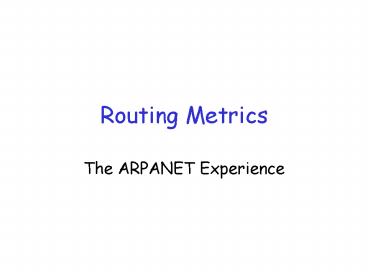Routing Metrics PowerPoint PPT Presentation
1 / 28
Title: Routing Metrics
1
Routing Metrics
- The ARPANET Experience
2
History
- The original ARPAnet was actually a terminal
concentrator network so lots of dumb terminals
could use a few big, expensive machines - In the early Internet, the ARPAnet became an
access network for little IP/TCP clients to use a
few big, expensive IP/TCP servers - In the adolescent Internet, the ARPAnet became a
transit network for widely distributed IP/TCP
local area networks - In the mature Internet, the ARPAnet faded to the
museums, but MILnet and clones remain for IP/TCP
and ITU-T legacy stuff
3
Importance of cost metric
- Choice of link cost defines traffic load
- low cost high probability link belongs to SPT
and will attract traffic, which increases cost. - Main problem convergence
- avoid oscillations
- achieve good network utilization
4
Metric choices
- Static metrics (e.g., hop count)
- good only if links are homogeneous
- definitely not the case in the Internet
- Static metrics do not take into account
- link delay
- link capacity
- link load (hard to measure)
5
Original routing algorithm
- Circa 1969
- Distance vector algorithm
- Routing tables exchanged every 2/3 seconds
6
Original ARPANET metric
- Cost proportional to queue size
- instantaneous queue length as delay estimator
- Problems
- did not take into account link speed
- poor indicator of expected delay due to rapid
fluctuations - delay may be longer even if queue size is small
due to contention for other resources
7
New algorithm
- Link state algorithm
- D-SPF (delay shortest path tree)
- Only link cost disseminated into the network
(standard LS approach), not routes
8
New metric
- Delay (depart time - arrival time)
transmission time link propagation delay - (depart time - arrival time) captures queuing
- transmission time captures link capacity
- link propagation delay captures the physical
length of the link - Measurements averaged over 10 seconds
- Update sent if difference gt threshold, or every
50 seconds
9
Performance of new metric
- Works well for light to moderate load
- static values dominate
- Oscillates under heavy load
- queuing dominates
- Reason there is no correlation between original
and new values of delay after re-routing!
10
Specific problems
- Range is too wide
- 9.6 Kbps highly loaded link can appear 127 times
costlier than 56 Kbps lightly loaded link - can make a 127-hop path look better than 1-hop
- No limit in reported delay variation
- All nodes calculate routes simultaneously
- triggered by link update
11
Example
A
Net X
Net Y
B
12
..example
After everyone re-calculates routes
A
Net X
Net Y
B
.. Oscillations!
13
Consequences
- Low network utilization (50 in example)
- Congestion can spread elsewhere
- Routes could oscillate between short and long
paths - Large swings lead to frequent route updates
- more messages
- frequent SPT re-calculation
14
Revised link metric
- Better metric packet delay f(queueing,
transmission, propagation). - When lightly loaded, transmission and propagation
are good predictors - When heavily loaded queuing delay is dominant and
so transmission and propagation are bad predictors
15
Revised Metric
- Avg utilization measurements limit range of
change.5sample .5last average - Normalize according to link type (e.g., satellite
should look good when queuing on other links
increases) - Max change allowed is link type specific
- change per update cannot be more than 1/2 of that
hops delay value (e.g. if max is 90 and min is
30, worst case is only 2 hops worse than best)
16
Routing metric v.s. link utilization
225
New metric (routing units)
9.6 satellite
140
90
9.6 terrestrial
75
56 satellite
60
56 terrestrial
30
0
50
100
25
75
Utilization
17
Observations
- Cost of highly loaded link never more than 3cost
when idle - Most expensive link is 7 least expensive link
- High-speed satellite link is more attractive than
low-speed terrestrial link
18
..observations
- Cost f(link utilization) only at moderate to
high loads - Allows routes to be gradually shed from link
- also takes into account link characteristics
19
Routing Characteristics
- Vern Paxson used traceroute to study 40,000
routes - Probability of encountering serious route failure
1/30 with problem lasting 30 seconds - 2/3 of routes persist for days or weeks
- 1/3 of route use different path in each
direction. - Routes becoming less predictable
20
Mobile IP
21
Architecture Entities
- Mobile Node
- Home Agent
- where the mobile node is registered permanently
- Foreign Agent
- where the mobile node visits currently
22
Protocol Overview
- Agent Discovery
- Home agents and foreign agents may advertise
their availability. - On the contrary, a newly arrived mobile node can
send a solicitation to learn if any prospective
agents are present. - Registration
- When the mobile node is away from home, it
registers its care-of address with its home agent.
23
Routing for Mobile Hosts
24
Mobile Routers
- A mobile node can also be a foreign agent
(similar to a router) of other mobile nodes. - Ex servers in airplane, train, car, etc.
home agent of x
Airplane
home agent of y
Airport
x
y
Internet
foreign agent of y
foreign agent of x
a sender to y
Ground Station
25
Proxy ARP
- Proxy ARP (RFC 925)
- an ARP Reply sent by one node on behalf of
another node which is either unable or unwilling
to answer its own ARP Requests - The ARP Proxy supplies ARP Reply with
- its own link-layer address
- IP of the proxyee (the mobile node).
- The receiver of the Reply then associates the
proxys link-layer address with the proxyees IP
address, causing future datagrams being directed
to the proxy.
26
Handoff
27
Handoff
28
Handoff

